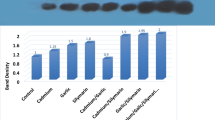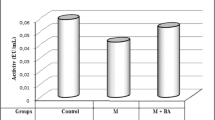Abstract
Exposure of animals to cadmium (Cd) (25 mg kg-1 body wt day-1) for 10 weeks resulted in preferential accumulation of the metal in liver and kidney. Cd accumulation concomitantly increased zinc (Zn) concentration in both the organs. However, significant decrease in copper level was observed in liver, whereas kidney showed increase in copper (Cu) level. Cd exposure resulted in decreased total GST activity in liver (63%) and kidney (41%) as compared to control group monkeys on normal diet (group I). On isoelectric focusing (IFP) control liver GST segregated into thirteen isoenzymes, while in Cd-treated experimental animals (group II) liver GST resolved into nine isoenzymes. Similarly kidney GST from control animals separated into seven isoenzymes as compared to four isoenzymes from Cd-treated animals. Kinetic analysis showed that Cd exposure did not alter the affinity constant (Km) of GST for GSH and CDNB whereas maximal velocity (Vmax) for these substrates decreased as compared to controls in both the organs, indicating inhibition in GST synthesis by Cd. Cd resulted in a noncompetitive type of inhibition with respect to GSH in vitro. On isoelectric focussing GST of liver and kidney in group II resolved into nine and four isoenzymes as compared to thirteen and seven in group I, showing loss of four basic isoenzymes in case of liver and three isoenzymes in case of kidney. Monkey liver and kidney expressed all the three classes of GST isoenzymes i.e. α, µ and π, which were serologically identical to human α, µ and π GSTs. (Mol Cell Biochem 166: 55-63, 1997)
Similar content being viewed by others
References
Booth J, Boyland E, Sims P: An enzyme from rat liver catalyzing conjugations with glutathione. Biochem J 79: 516–524, 1961
Litwack G, Ketterer B, Arias IM: Ligandin: a hepatic protein which binds steroids, bilirubin, carcinogens and a number of exogenous organic anions. Nature London 234: 466–467, 1971
Jakoby WB: The glutathione S-transferases: a group of multifunctional detoxification proteins. Adv Enzymol Relat Areas Molec Biol 46: 383–414, 1978
Probaska JR, Ganther HE: The glutathione peroxidase activity of glutathione S-transferases. Biochem Biophys Res Commun 76: 437–445, 1977
Clifton G, Kaplowitz N: Effect of dietary phenobarbital 3,4-benzo(a) pyrene and 3-methylcholanthrene or hepatic, intestinal and renal glutathione S-transferase activities in the rat. Biochem. Pharmacol. 27: 1284–1287, 1978
Mannervik B, Danielson UH: Glutathione transferases. Structure and catalytic activity. CRC Crit Rev Biochem 23: 283–336, 1988
Friberg L, Piscator M, Nordberg CF, Kjellstrom T: Cadmium in the environment 2nd ed. Cleveland CRC Press, 1974
Cherian MG, Goyer RA: Metaliothioncins and their role in the metabolism and toxicity of metals. Life Sci 23: 1–9, 1978
Vallee BL, Ulmer DD: Biochemical effects of mercury, cadmium and lead. Ann Rev Biochem 41: 91–128, 1972
Ochi T, Ishiguro T, Ohsawa M: Participation of active oxygen species in the induction of DNA single-strand scission by cadmium chloride in cultured Chinese hamster cells. Mutation Res. 122: 169–175, 1983
Reddy CC, Scholz RW, Massaro EJ: Cadmium, methylmercury, mercury and lead inhibition of calf liver glutathione S-transferase exhibiting selenium-independent glutathione peroxidase activity. Toxicol Appl Pharmacol 610: 460–468, 1981
Dierickx PJ: In vitro inhibition of the soluble glutathione S-transferases from rat liver by heavy metals. Enzyme 27: 25–32, 1982
Paliwal VK, Kohlie KK, Sharma M, Nath R: Purification and characterization of metallothionein from liver of cadmium exposed Rhesus monkeys (Macaca mulatta). Mol Cell Biochem 71(2): 139–147, 1986
Habig WH, Pabst MJ, Jakoby WB: Glutathione S-transferases: The first enzymatic step in mercapturic acid formation. J Biol Chem 249: 7130–7139, 1974
Lowry OH, Rosebrough NJ, Farr AL, Randall RJ: Protein measurement with the Folin phenol reagent. J Biol Chem 193: 265–275, 1951
Vander Jagt DL, Hunsaker LA, Gracia KB, Boyer RE: Isolation and characterization of the mu'tiple glutathione S-transferases from human liver. Evidence for unique home binding sites. J Biol Chem 260: 11603–11610, 1985
Killick KA: Analysis of glutathione S-transferase from human liver by isoelectric focusing in a urea minigel system. Analyt Biochem 195: 255–261, 1991
Singh SV, Leal T, Ansari GAS, Awasthi YC: Purification and characterization of glutathione S-transferases of human kidney. Biochem J 246: 179–186, 1987
Scheuhammer AM: The dose-dependent deposition of cadmium into organs of Japanese quail following oral administration Toxicol Appl Pharmacol 95: 153–161, 1988
Jonah MM, Bhattacharyya MH: Early changes in the tissue distribution of cadmium after oral but not intravenous cadmium exposure. Toxicology 58: 325–338, 1989
Sidhu M, Sharma M, Bhatia M, Awasthi YC, Nath R: Effect of chronic cadmium exposure on glutathione S-transferase and glutathione peroxidase-activities in Rhesus monkey: The role of selenium. Toxicol 83: 203–213, 1993
Cousins RJ: Absorption, transport and hepatic metabolism of copper and zinc: Special reference to metallothionein and ceruloplasmin. Physiol Reviews 65: 239–309, 1985
Stonard MD, Webb M: Influence of dietary cadmium on the distribution of the essential metals copper, zinc and iron in tissues of the rat. Chem Biol Interactions 15: 349–363, 1976
Freeland JH, Cousins RJ: Effect of dietary cadmium on anemia, iron absorption and cadmium binding protein in the chick. Nutr Rep Int 8: 337–347, 1973
Prasad R, Nath R: Cadmium-induced nephrotoxicity in Rhesus monkeys (Macaca mulatta) in relation to protein calorie malnutrition. Toxicol 100: 89–100, 1995
Nath R, Kambadur R, Gulati S, Paliwal VK, Sharma M: Molecular aspects, physiological function and clinical significance of metallothioneins. Crit Rev Food Sci Nutr 27(1): 41–85, 1988
Hoesch RM, Boyer TD: Purification and characterization of hepatic glutathione S-transferases of rhesus monkeys. Biochem J 251: 81–88, 1988
Tsuchida S, Sato K: Glutathione transferases and cancer. CRC Crit Rev Biochem Mol Biol 27(4,5): 337–384, 1992
Coles B, Ketterer B: The role of glutathione and glutathione transferases in chemical carcinogenesis. Crite Rev Biochem Mol Biol 25(1): 47–70, 1990
Mannervik B, Alin P, Guthenberg C, Jensson H, Tahir MK, Warholm M, Jornvall H: Identification of three classes of cytosolic giutathione transferase common to several mammalian species: Correlation between structural data and enzymatic properties. Proc Natl Acad Sci USA 82: 7202–7206, 1985
Widersten M, Holmstrom E, Mannervik B: Cysteine residues are not essential for the catalytic activity of human class Mu glutathione transferase M 1a-1a. FEBS Lett 293(1, 2): 156–159, 1991
Schäffer J, Gallay O, Ladenstein R: Glutathione transferase from bovine placenta. Preparation, biochemical characterization, crystallization and preliminary crystallographic analysis of a neutral class Pi enzyme. J Biol Chem 263: 17405–17411, 1988
Ricci G, Del Boccio G, Pennelli A, Aceto A, Whitehead EP, Federici G: Nonequivalence of the two subunits of horse erythrocyte glutathione transferase in their reaction with sulfhydryl reagents. J Biol Chem 264: 5462–5465, 1989
Del Boccio G, Pennelli A, Whitehead EP, Lo Bello M, Petruzzelli R, Federici G, Ricci G: Interaction of glutathione transferase from horse erythrocytes with 7-chloro-4-nitrobenzo-2-oxa 1,3-diazole. J Biol Chem 266: 13777–13782, 1991
Adang AEP, Moeree WJ, Brussee J, Mulder GJ, Vander Gen A: Inhibition of rat glutathione S-transferase 3–3 by glutathione derivative that bind covalently to active site. Biochem J 278: 63–68, 1991
Author information
Authors and Affiliations
Rights and permissions
About this article
Cite this article
Sidhu, M., Prasad, R., Gill, K.D. et al. Alterations in isoforms of glutathione S-transferase in liver and kidney of cadmium exposed rhesus monkeys: Purification and kinetic characterization. Mol Cell Biochem 166, 55–63 (1997). https://doi.org/10.1023/A:1006849431209
Issue Date:
DOI: https://doi.org/10.1023/A:1006849431209




